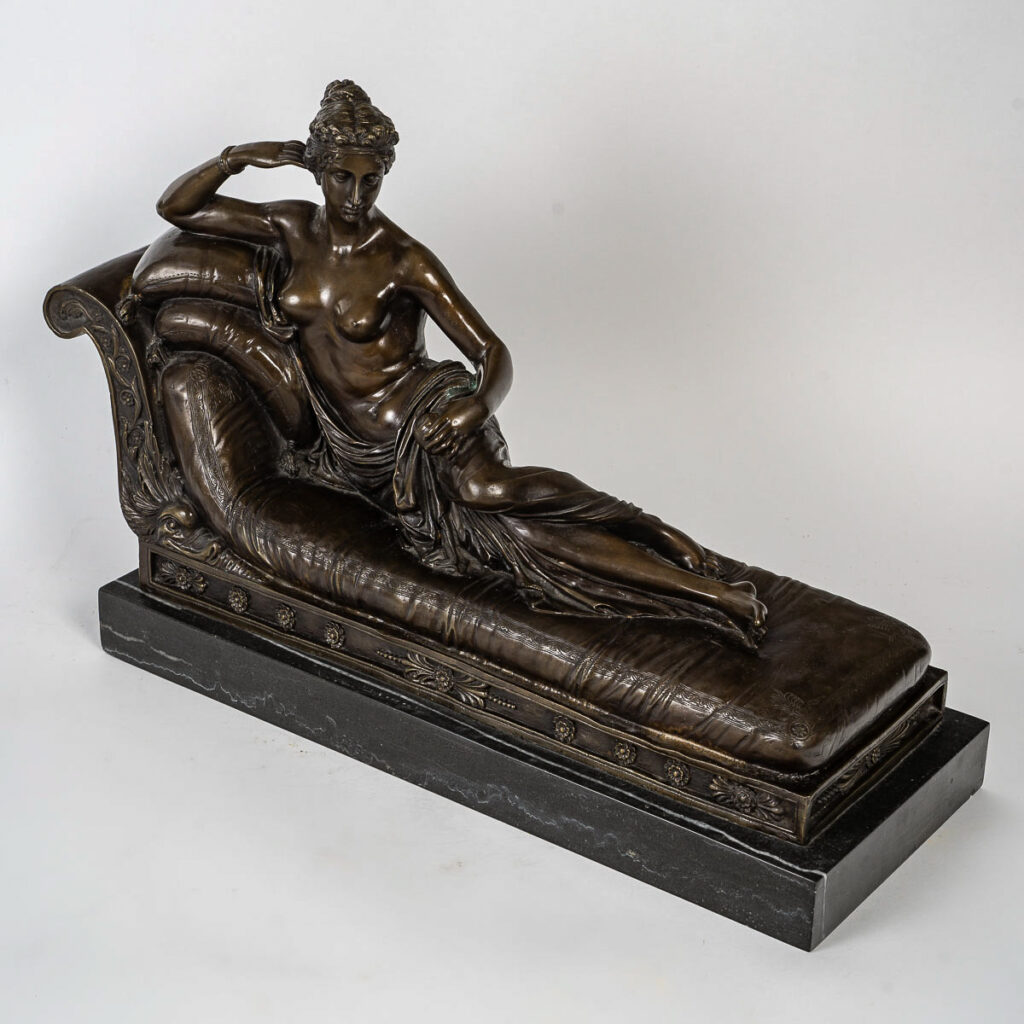D’après Antonio Canova (1757-1822) – Pauline Borghèse dite Venus Vitrix en bronze et marbre vers 1860-1880
Stamp of Bronze Garanti Paris J.B Déposé n° A 1149, a guarantee of quality that renders this splendid bronze after Antonio Canova by Pauline Borghese, known as Venus Vitrix, highly sought-after by discerning collectors.
Sculptée de 1805 à 1808 par le célèbre sculpteur Canova, cette Vénus avait été commandée par Camille Borghèse, second mari de Pauline Bonaparte. Elle représente une Vénus victorieuse, le corps dévoilé, allongée à l’antique sur un klinê, langoureusement accoudée sur un coussin, tenant une pomme évoquant le jugement de Pâris.
Prenant pour modèle la princesse qui posa nue pour la sculpture, l’œuvre fit scandale. L’original, sculpté à Rome, sera placé plus tard à la galerie Borghèse, tandis qu’une réplique trouve sa place aujourd’hui à l’ambassade britannique, ancien hôtel particulier de la princesse. Pauline posera encore auprès du sculpteur pour la Galatée.
High quality in this finely chased bronze with a beautiful brown patina resting on a beautiful veined gray marble. French work bearing the guarantee stamp of the Bronzier de Paris n° A 1149 circa 1860-1880.
Dimensions : Hauteur : 35 cm – Longueur 54 cm – Profondeur 19 cm.
In very fine condition, our bronze shows minor patina wear, which contributes to the charm of this sculpture.
Biography:
Antonio Canova was a Venetian sculptor and painter, born on November 1, 1757 in Possagno and died on October 13, 1822 in Venice.
Né à Possagno, possession de la République de Venise, dans une famille de tailleurs de pierre depuis des générations, il apprend dès son plus jeune âge l’art de la taille du marbre.
En 1768, sur la recommandation du sénateur Giovanni Falier, il est placé comme apprenti chez le sculpteur Giuseppe Bernardi, à Pagnano, avant d’intégrer l’école Santa Marina à Venise.
Après avoir remporté plusieurs prix à l’Académie des beaux-arts de Venise, il y donne successivement plusieurs ouvrages qui le mettent bientôt au premier rang des sculpteurs modernes, et dans lesquels il sait allier l’imitation de la nature avec les beautés idéales à l’antique.
Il étudie l’art antique et sculpte, tout au long de sa vie, diverses statues inspirées des mythologies grecques et romaines, ainsi que des cénotaphes, des bustes et des statues en pied de divers personnages célèbres de l’époque.
Il est renommé pour la délicatesse de ses sculptures sur marbre. Son œuvre est considérée comme l’archétype de la sculpture néoclassique et a fait l’objet de plusieurs études de Mario Praz.
Il consacre une bonne partie de sa fortune que lui valait son art à des activités de bienfaisance ou de soutien à de jeunes artistes ou d’artistes dans le besoin.
Il pratique également la peinture avec succès. Appelé plusieurs fois à Paris par Napoléon, il revient en 1815, chargé par le pape de présider à la reconnaissance et à la translation des monuments enlevés à Rome et que réclame le gouvernement pontifical en application des clauses du Congrès de Vienne. Il est chargé de négocier avec Dominique Vivant Denon la restitution, par la France, des œuvres d’art italien volées par l’armée napoléonienne.
He was knighted and received several honors.
À sa mort en 1822, son cœur est déposé à l’église vénitienne Santa Maria Gloriosa dei Frari, dans un monument funéraire de sa propre création, bien qu’il l’eût originellement dédié au peintre Titien. Sa dépouille, quant à elle, est inhumée à Possagno, dans le Tempio Canoviano où est enterré également son frère.
Bronze Garanti Paris J.B Déposé A 1149:
Le cachet Bronze, Garanti Paris J.B. Déposé, est une indication de la qualité et de l’origine d’une sculpture en bronze. Il est souvent associé à des fonderies parisiennes renommées, telles que la fonderie Susse Frères, la fonderie Barbedienne et la fonderie Thiébaut Frères. Les sculptures en bronze portant ce cachet sont des pièces de collection recherchées par les amateurs d’art.




